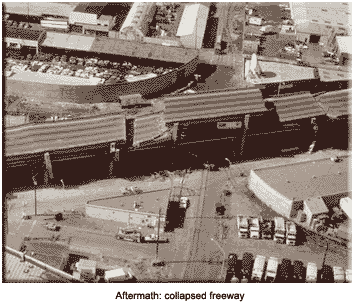Death, destruction, and havoc were again visited upon the San Francisco area in 1989. Reminiscent of the 1906 earthquake, the earth shook, like a table bumped, causing a house of cards to fall.
 The Loma Prieta — literally, dark knoll — earthquake occurred on October 17, 1989, in the greater San Francisco Bay Area in California at 5:04 p.m. local time and measured 7.1 on the Richter magnitude scale. The earthquake lasted for 15 to 20 seconds. Its epicenter was at geographical coordinates 37.04° N 121.88° W, near Loma Prieta Peak in the Santa Cruz Mountains, about 10 miles northeast of the city of Santa Cruz, California, in the Forest of Nisene Marks State Park. The fault rupture did not break the ground surface. The focal depth was 11 miles, which is unusually deep. Typical California earthquake focal depths are 4 to 6 miles. That earthquake was the largest to occur in the San Francisco Bay area since 1906.
The Loma Prieta — literally, dark knoll — earthquake occurred on October 17, 1989, in the greater San Francisco Bay Area in California at 5:04 p.m. local time and measured 7.1 on the Richter magnitude scale. The earthquake lasted for 15 to 20 seconds. Its epicenter was at geographical coordinates 37.04° N 121.88° W, near Loma Prieta Peak in the Santa Cruz Mountains, about 10 miles northeast of the city of Santa Cruz, California, in the Forest of Nisene Marks State Park. The fault rupture did not break the ground surface. The focal depth was 11 miles, which is unusually deep. Typical California earthquake focal depths are 4 to 6 miles. That earthquake was the largest to occur in the San Francisco Bay area since 1906.
Sources place the death toll at between 63 to 68 people. Deaths in Santa Cruz occurred when brick storefronts and sidewalls in the historic downtown (what was then called the Pacific Garden Mall) tumbled down on people exiting the buildings.
The earthquake caused severe damage as far as 70 miles away, most notably in San Francisco, Oakland, the San Francisco Peninsula, and in areas closer to the epicenter in the communities of Santa Cruz, Watsonville, and Los Gatos. Extensive damage also occurred in San Francisco's Marina District, where many expensive homes built on filled ground collapsed from liquefaction of soil used over the years to fill in the waterfront and then built upon.
In addition, more than 1,000 landslides and rockfalls occurred in the epicentral zone in the Santa Cruz Mountains. One slide, on State Highway 17, disrupted traffic for about a month. Property damage was estimated at $6 billion.
The earthquake interrupted the World Series between the San Francisco Giants and the Oakland Athletics. Fortunately, less than half of the 65,000-plus fans had reached their seats, lessening the load on the structure of the stadium.
Because the quake occurred during the evening rush hour, there could have been a large number of cars on the freeways at the time, which might have endangered many hundreds of commuters. Fortunately, in an unusual convergence of events, many people had left work early or were participating in World Series early after-work parties. Therefore, the usually crowded highways bore exceptionally light traffic at the time.
One of the major impacts of the earthquake on everyday life was transportation. The earthquake caused the Cypress Viaduct to collapse, resulting in 42 deaths. The viaduct was a raised freeway section that was part of the Nimitz freeway in Oakland, which is Interstate 880. The viaduct had two traffic decks. Resonant vibration caused 50 of the 124 spans of the Viaduct to collapse. The reinforced concrete frames of those spans were mounted on weak soil. As a result, the natural frequency of those spans coincided with the forcing frequency of the earthquake ground motion. The viaduct structure thus amplified the ground motion. The spans suffered increasing vertical motion. Cracks formed in the support frames. Finally, the upper roadway collapsed, slamming down on the lower road, crushing the cars on the lower deck.
The earthquake forced the closure and demolition of San Francisco's Embarcadero Freeway (Interstate 480); that demolition opened up San Francisco's Embarcadero waterfront to new development. The concrete freeway, which ran along San Francisco's waterfront and was never completed, was replaced with a ground-level boulevard. Seismic damage also forced the long-term closure of Interstate 280 in San Francisco (north of US-101), another concrete freeway that had never been completed on its originally planned route. The highway remained closed for seven years, with its repair experiencing numerous delays.
The Loma Prieta earthquake irrevocably changed the San Francisco Bay Area's transportation landscape. The quake also forced seismic retrofitting of all San Francisco Bay Area bridges.